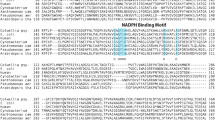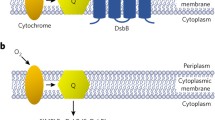Summary
The redox interconversion of Escherichia coli glutathione reductase has been studied both in situ, with permeabilized cells treated with different reductants, and in vivo, with intact cells incubated with compounds known to alter their intracellular redox state.
The enzyme from toulene-permeabilized cells was inactivated in situ by NADPH, NADH, dithionite, dithiothreitol, or GSH. The enzyme remained, however, fully active upon incubation with the oxidized forms of such compounds. The inactivation was time-, temperature-, and concentration-dependent; a 50% inactivation was promoted by just 2 μM NADPH, while 700 μM NADH was required for a similar effect. The enzyme from permeabilized cells was completely protected against redox inactivation by GSSG, and to a lesser extent by dithiothreitol, GSH, and NAD(P)+. The inactive enzyme was efficiently reactivated in situ by physiological GSSG concentrations. A significant reactivation was promoted also by GSH, although at concentrations two orders of magnitude below its physiological concentrations. The glutathione reductase from intact E. coli cells was inactivated in vivo by incubation with DL-malate, DL-isocitrate, or higher L-lactate concentrations. The enzyme was protected against redox inactivation and fully reactivated by diamide in a concentration-dependent fashion. Diamide reactivation was not dependent on the synthesis of new protein, thus suggesting that the effect was really a true reactivation and not due to de novo synthesis of active enzyme. The glutathione reductase activity increased significantly after incubation of intact cells with tert-butyl or cumene hydroperoxides, suggesting that the enzyme was partially inactive within such cells. In conclusion, the above results show that both in situ and in vivo the glutathione reductase of Escherichia coli is subjected to a redox interconversion mechanism probably controlled by the intracellular NADPH and GSSG concentrations.
Similar content being viewed by others
References
Williams CH Jr: Flavin-dependent dehydrogenases and oxidases. In PD Boyer (ed) The Enzymes, Vol XIII, Academic Press, New York, 1976, pp 89–173.
Mata AM, Pinto MC, López-Barea J: Purification by affinity chromatography of glutathione reductase (EC 1.6.4.2) from Escherichia coli and characterization of such enzyme. Z Naturforsch 39c:908–915, 1984.
López-Barea J, Lee C-Y. Mouse-liver glutathione reductase. Purification, kinetics and regulation. Eur J Biochem 98:487–499, 1979.
López-Barea J: Mouse-liver glutathione reductase: inactivation by NADPH of two allelic variants. Rev Esp Fisiol 37: 249–254, 1981.
Pinto MC, Mata AM, López-Barea J: Reversible inactivation of Saccharomyces cerevisiae glutathione reductase under reducing conditions. Arch Biochem Biophys 228:1–12, 1984.
Pinto MC, Mata AM, Lopez-Barea J: On the redox interconversion mechanism of Saccharomyces cerevisiae glutathione reductase. Eur J Biochem (in press).
Serrano A, Rivas J, Losada M: Purification and properties of glutathione reductase from the cyanobacterium Anabaena sp. strain 7119. J Bacteriol 158:317–324, 1984.
Mata AM, Pinto MC, López-Barea J: Redox interconversion of glutathione reductase from Escherichia coli. A study with pure enzyme and cell-free extracts. Mol Cell Biochem 67:65–76, 1985.
Weitzman PDJ: Behaviour of enzymes at high concentration. Use of permeabilized cells in the study of enzyme activity and its regulation. FEBS Letters 32:247–250, 1973.
Reeves RE, Sols A: Regulation of Escherichia coli phosphofructokinase in situ. Biochem Biophys Res Commun 50:459–466, 1973.
Borthwick AC, Holms WH, Nimmo HG: The phosphorylation of Escherichia coli isocitrate dehydrogenase in intact cells. Biochem J 222:797–804, 1984.
Williamson DH, Lund P, Krebs HA: The redox state of free nicotinamide-adenine dinucleotide phosphate in the cytoplasm and mitochondria of rat liver. Biochem J 103:514–527, 1967.
Veech RL, Eggleston LV, Krebs HA: The redox state of free nicotinamide-adenine dinucleotide phosphate in the cytoplasm of rat liver. Biochem J 115:609–619, 1969.
Sies H, Gerstenecker C, Menzel H, Flohé L: Oxidation in the NADP system and release of GSSG from hemoglobinfree perfused rat liver during peroxidatic oxidation of glutathione by hydroperoxides. FEBS Letters 27:171–175, 1972.
Srivastava SK, Awasthi YC, Beutler E: Useful agents for the study of glutathione metabolism in erythrocytes. Organic hydroperoxides. Biochem J 139:289–295, 1974.
Sies H, Summer K-H: Hydroperoxide-metabolizing systems in rat liver. Eur J Biochem 57:503–512, 1975.
Kosower NS, Kosower EM, Wertheim B, Correa WS: Diamide, a new reagent for the intracellular oxidation of glutathione to the disulfide. Biochem Biophys Res Commun 37: 593–596, 1969.
Kosower EM, Correa W, Kinon BJ, Kosower NS: Glutathione VII. Differentiation among substrates by the thiol-oxidizing agent, diamide. Biochim Biophys Acta 264:39–44, 1972.
Miller JH: Experiments in molecular genetics. Cold Spring Harbor Laboratory, Cold Spring Harbor, 1972, p 431.
Moses RE: DNA synthesis in toluene-treated cells of Escherichia coli. Methods Enzymol 29:219–224, 1974.
Omachi A, Scott CB, Hegarty H: Pyridine nucleotides in human erythrocytes in different metabolic states. Biochim Biophys Acta 184:139–147, 1969.
Akerboom TPM, Sies H: Assay of glutathione, glutathione disulfide and glutathione mixed disulfides in biological samples. Methods Enzymol 77:373–382, 1981.
Jocelyn PC: Reduction of diazenes and hydroperoxides by rat liver mitochondria. In Sies H and Wendell A (eds) Functions of glutathione in liver and kidney. Springer-Verlag, Berlin, 1978, pp 127–138.
Barbado C, Ramirez M, Blanco MA, López-Barea J, Pueyo C: Mutants of Escherichia coli sensitive to hydrogen peroxide. Current Microbiol 8:251–253, 1983.
Harris JW, Biaglow JE: Non-specific reactions of the glutatione oxidant ‘diamide’ with mammalian cells. Biochem Biophys Res Commun 46:1743–1749, 1972.
Bindoli A, Cavallini L, Siliprandi N, Zoccarato F: Action of some thiol oxidizing agents on mitochondrial sulphydryl groups. Bull Mol Biol Med 1:92–96, 1976.
Hibberd KA, Berget PB, Warner HR, Fuchs JA: Role of glutathione in reversing the deleterious effects of a thiol oxidizing agent in Escherichia coli. J Bacteriol 133:1150–1155, 1978.
Author information
Authors and Affiliations
Rights and permissions
About this article
Cite this article
Mata, A.M., Pinto, M.C. & López-Barea, J. Redox interconversion of Escherichia coli glutathione reductase. A study with permeabilized and intact cells. Mol Cell Biochem 68, 121–130 (1985). https://doi.org/10.1007/BF00219376
Received:
Issue Date:
DOI: https://doi.org/10.1007/BF00219376




